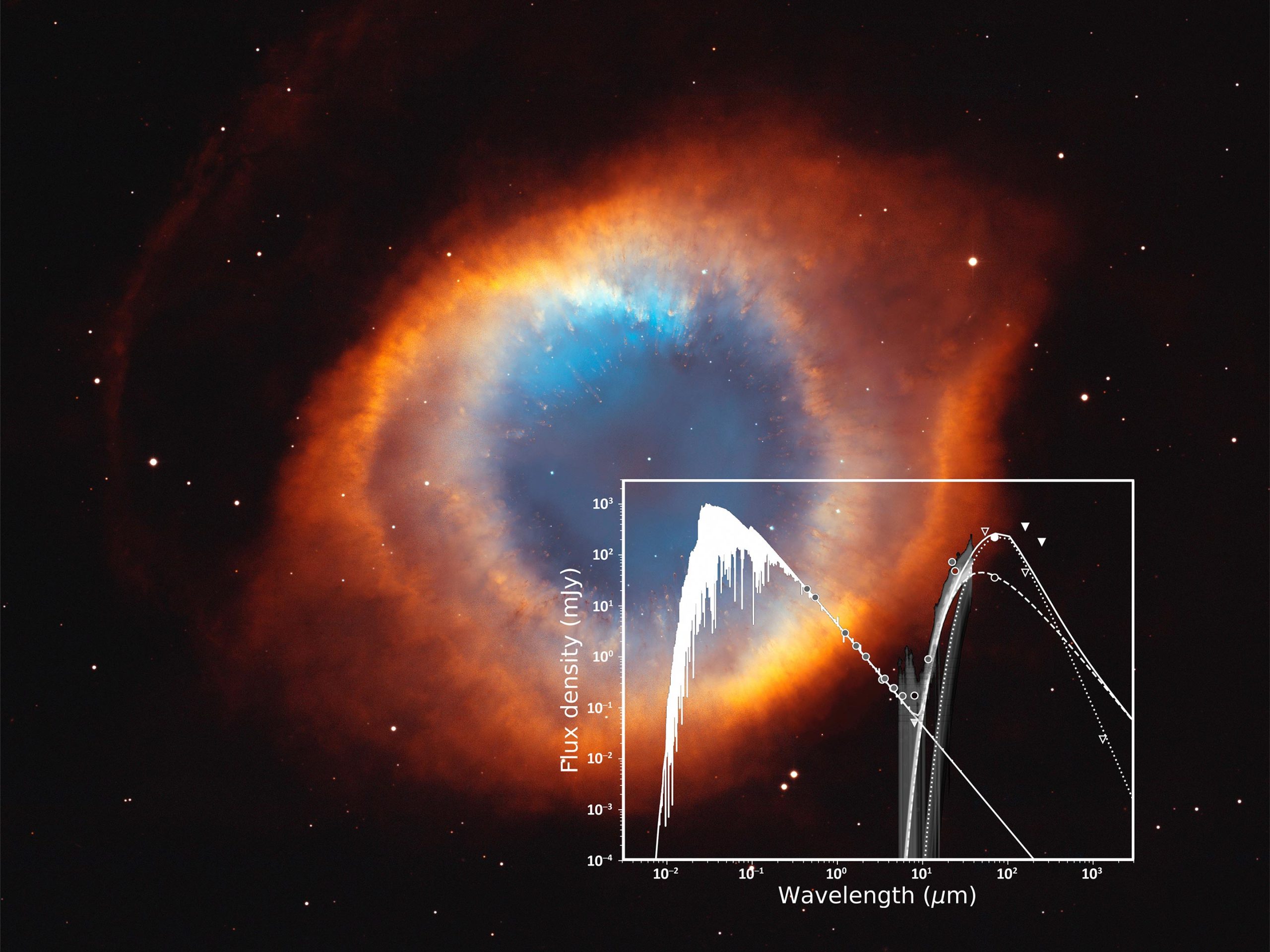
يتم فرض توزيع الطاقة الطيفية لـ WD 2226-210 على صورة سديم اللولب من تلسكوب هابل الفضائي. تجمع المؤامرة بين القياس الضوئي البصري والأشعة تحت الحمراء والمليمتر ، وطيف سبيتزر للأشعة تحت الحمراء المتوسطة ، والحدود العليا من Weiss ، و Spitzer ، و SOFIA ، و Herschel ، و ALMA. نماذج من هالة القزم الأبيض (الصلبة) وفائض الأشعة تحت الحمراء تظهر ملاءمة جيدة لاكتشافات البيانات (الدوائر) والحدود العليا (مثلثات). سديم اللولب. الائتمان: NOIRLab ؛ ائتمان SED: JP Marshall.
بمجرد أن يتطور النجم إلى ما وراء التسلسل الرئيسي – أطول مرحلة من مراحل التطور النجمي ، يتم خلالها معادلة الإشعاع الناتج عن الاندماج النووي في قلب النجم بالجاذبية – يصبح مصير أي نظام كوكبي لغزًا. لا يعرف علماء الفلك بشكل عام ما يحدث للكواكب بعد هذه النقطة ، أو ما إذا كان بإمكانهم البقاء على قيد الحياة.
في ورقة نشرت مؤخرا مجلة علم الفلكاستخدم الباحثون في مرصد الستراتوسفير لعلم الفلك بالأشعة تحت الحمراء البيانات الجديدة.[{” attribute=””>SOFIA) and the Atacama Large Millimeter/submillimeter Array (ALMA), as well as archival data from the Spitzer Space Telescope and the Herschel Space Observatory, to study the Helix Nebula. These observations provide one potential explanation for the fate of these planetary remains.
A Process of Elimination, and a Disruptive Origin
The Helix Nebula is an old planetary nebula – expanding, glowing gas ejected from its host star after its main-sequence life ended. The nebula has a very young white dwarf at its center, but this central white dwarf is peculiar. It emits more infrared radiation than expected. To answer the question of where this excess emission comes from, the astronomers first determined where it could not have come from.
Collisions between planetesimals – small, solid objects formed out of cosmic dust left over from the creation of a planetary system around a star – can produce this type of excess emission, but SOFIA and ALMA failed to see the large dust grains required for such objects to exist, ruling out one option. The astronomers also didn’t find any of the carbon monoxide or silicon monoxide molecules characteristic of the gas disks that can surround evolving post-main-sequence stellar systems that precede objects like the Helix Nebula, excluding another potential explanation.
Different strands of evidence place strict constraints on the size, structure, and orbit of the source of the emission, and eventually come together to identify the same culprit: dust – from full-fledged planets destroyed during the nebula’s formation – returning toward its inner regions.
“In piecing together the size and shape of the excess emission, and what those properties infer regarding the dust grains in the white dwarf environment, we conclude that a disrupted planetary system is the best solution to the question of how the Helix Nebula’s infrared excess was created and maintained,” said Jonathan Marshall, the lead author on the paper and a researcher at Academia Sinica in Taiwan.
Once they realized the remnants of a former planetary system are at the origin of the infrared emission, they calculated how many grains need to be returning to the Helix Nebula’s center to account for the emission: about 500 million over the 100,000-year lifetime of the planetary nebula, conservatively.
SOFIA’s Role
SOFIA’s capabilities fell right into a gap between the previous Spitzer and Herschel observations, allowing the group to understand the shape and brightness of the dust, and improving the resolution of how far it spreads out.
“This gap lay around where we expected the dust emission to peak,” Marshall said. “Pinning down the shape of the dust emission is vital to constraining the properties of the dust grains that produce that emission, so the SOFIA observation helped refine our understanding.”
Though the researchers are not planning any follow-up observations of the Helix Nebula in particular, this study is a piece in a larger effort to use observations to understand what happens to planetary systems once their star evolves past the main sequence. The group hopes to study other late-stage stars using similar techniques.
Reference: “Evidence for the Disruption of a Planetary System During the Formation of the Helix Nebula” by Jonathan P. Marshall, Steve Ertel, Eric Birtcil, Eva Villaver, Francisca Kemper, Henri Boffin, Peter Scicluna and Devika Kamath, 19 December 2022, The Astronomical Journal.
DOI: 10.3847/1538-3881/ac9d90
SOFIA was a joint project of NASA and the German Space Agency at DLR. DLR provided the telescope, scheduled aircraft maintenance, and other support for the mission. NASA’s Ames Research Center in California’s Silicon Valley managed the SOFIA program, science, and mission operations in cooperation with the Universities Space Research Association, headquartered in Columbia, Maryland, and the German SOFIA Institute at the University of Stuttgart. The aircraft was maintained and operated by NASA’s Armstrong Flight Research Center Building 703, in Palmdale, California. SOFIA achieved full operational capability in 2014 and concluded its final science flight on September 29, 2022.

“متعصب التلفزيون. مدمن الويب. مبشر السفر. رجل أعمال متمني. مستكشف هواة. كاتب.”







More Stories
خريطة جديدة للمريخ تكشف عن “هياكل” مخفية تحت سطح المريخ
زوج من نفاثات البلازما الضخمة تندلع من ثقب أسود هائل | الثقوب السوداء
الأسمنت المستوحى من عظام الإنسان أصعب بخمس مرات من الخرسانة العادية